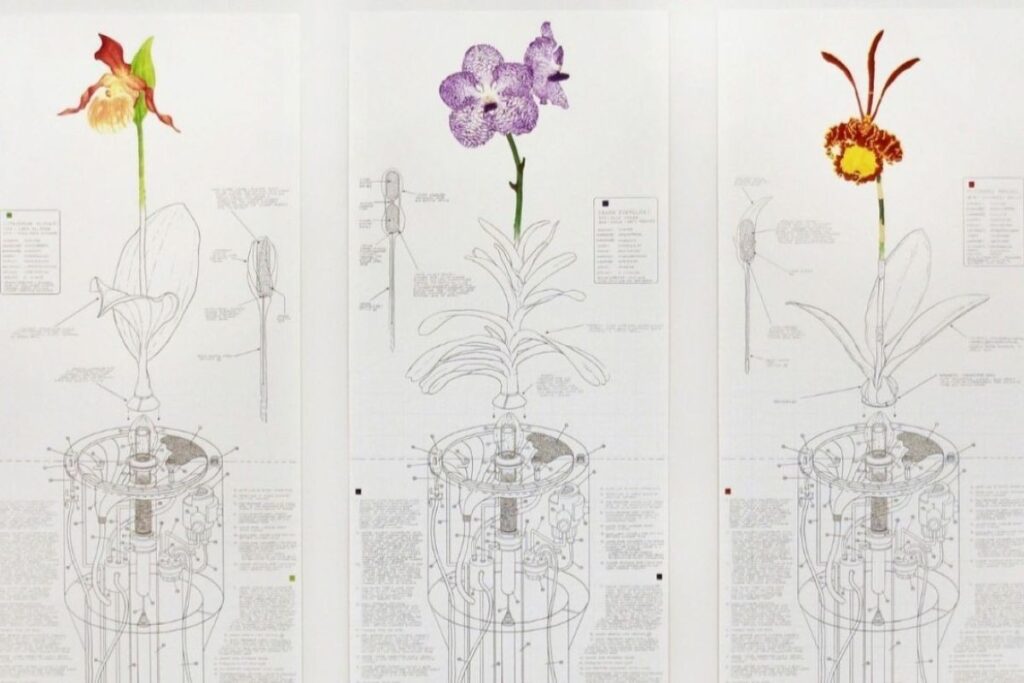It’s an inspired setting for a show which evokes ‘an opulent greenhouse or the glasshouses of a botanical garden’.
Here, curated by Melanie Erixson, Justin Amrhein’s Mechanical Orchids sweep down the wide spiral staircase beneath the high glass ceiling into which sunlight pours from the open sky above, wrapping the show’s intriguing centrepiece in flowers and colour.
These Mechanical Orchids are a series of 33 schematic drawings on paper depicting mechanical “replacements” for orchid species from around the globe. These are collaborative works that imaginatively fuse detailed schematic drawings with botanical brilliance.
“We may have incredible technology, says Justin, “but if we may find ourselves having to use human ingenuity to recreate the plant life we are destroying. The idea that we could replicate or replace orchids mechanically is tongue-in-cheek and there’s a darker side to the drawings. They serve to remind us of what we’ll lose as we kill the planet’s natural resources. They’re a warning,” he continues. “Even if we could make replica mechanical flowers, they’d be inefficient compared with the irreplaceable organic versions, the incredible ‘biological machines’ that we take for granted.”
Despite this, Justin has taken the time to consider carefully how we might mechanically recreate nature and each of the drawings incorporates many small details. “I might consider how can I make something to provide pollen for bees to make honey, for example,” he explains.
The idea for this exhibition – and this collaborative series – grew from an earlier triptych of the Vandachostylis Lou Sneary, the Lady Slipper and a butterfly orchid.
“I particularly like orchids because they’re incredibly beautiful and they’re also pretty simplistic in terms of how they grow. Their tall straight stem worked perfectly with my question about how could we make a flower grow mechanically? I also liked the idea that because there are so many species, that if there really was a mechanical orchid, the ‘seed’ or mechanical stem could be modified to generate many different orchid species. It can be an endless series because the more you research orchids the more incredible species you find! There are thousands and thousands,” he enthuses.”
As well as fusing the mechanical and the botanical, Justin further developed the series by fusing his technical drawing template with the work of a network of artists that he’d ‘grown and collected’ over the years. “There’s a big hybrid orchid industry – the result of cross- pollinating two orchids to create a new variety,” he smiles, “and so cross-fertilising my mechanical component with other artists’ work felt just right.”
In addition to adding an exciting new dimension to the works, this collaboration with other artists from around the world – including Ryan Falzon, Martina Darmanin and Ruth Ancilleri from Malta – incorporates Justin’s personal narrative into the project. “The artists represent the trajectory of my life and people I have known,” he explains. “One of the orchids, for example, was drawn by my high school art teacher in Sacramento, California; others are by artists with whom I worked with at Pierogi Gallery in Brooklyn. I am also thrilled to include a work by Shelby Smith, a multimedia artist and ceramicist who went to grad school with me in California with whom I kept in touch on social media. On his Instagram I could see he had become huge orchid enthusiast, growing varieties himself and making ceramic pots for people in the orchid industry in Hawaii. He participates in big orchid fairs there and so I asked him to take photographs of the many different species for me. Then each of the 30 collaborating artists interpreted the photo in their own way, in oils, acrylics, watercolours, graphite or collage.
In the atrium itself at the foot of the stairs, there are five additional works – including a large mechanical drawing of Malta’s national flower. This Maltese centaury is flanked by two cyanotypes of other mechanical endangered flowers, the iconic blue lines of cyanotypes fortuitously referencing the idea of a schematic design blueprint.
These also serve as a great introduction to a futuristic dimension to the show – both here at Sapzju Kreattiv and, next month, at MUŻA. In the centre of the atrium there’s both a real palm tree standing 7.5 metres tall, it’s skinny and tall shape echoing that of an orchid – and, hanging from the ceiling, a full-size 2D mechanical botanical equivalent on translucent frosted mylar paper. The 3D biological original has been wrapped in a toweringly tall cylindrical base with R2D2 white with blue styling as if has been grown mechanically. It’s a show-stopping centrepiece.
This is a mere taster of a follow-on show, the second in the artist’s Malta exhibition diptych, supported by Arts Council Malta, in which Amrhein will take over two spaces at MUŻA (from July 4) with 3D blueprint sculptures that extend the ideas in Dystopian Garden both conceptually and aesthetically.
Dystopian Garden, at Spazju Kreattiv, runs until June 22
